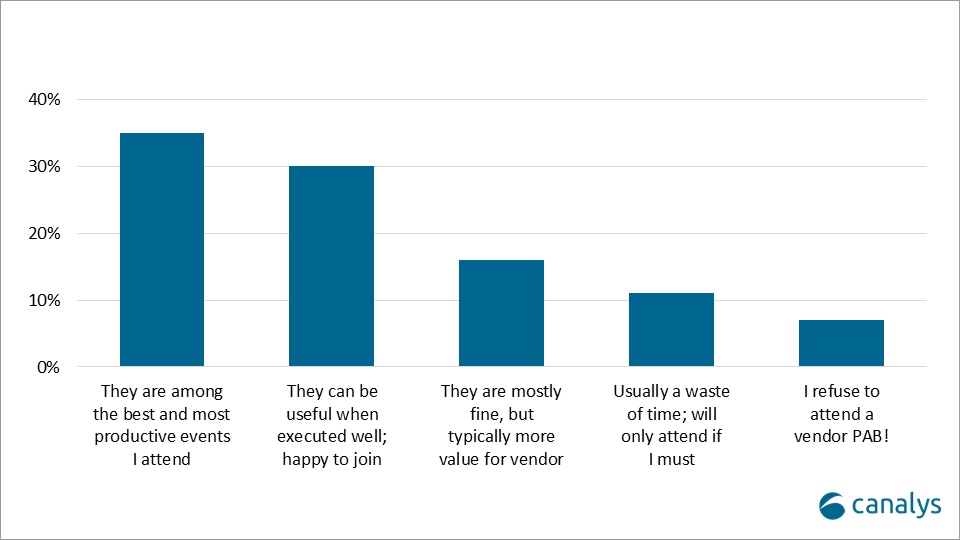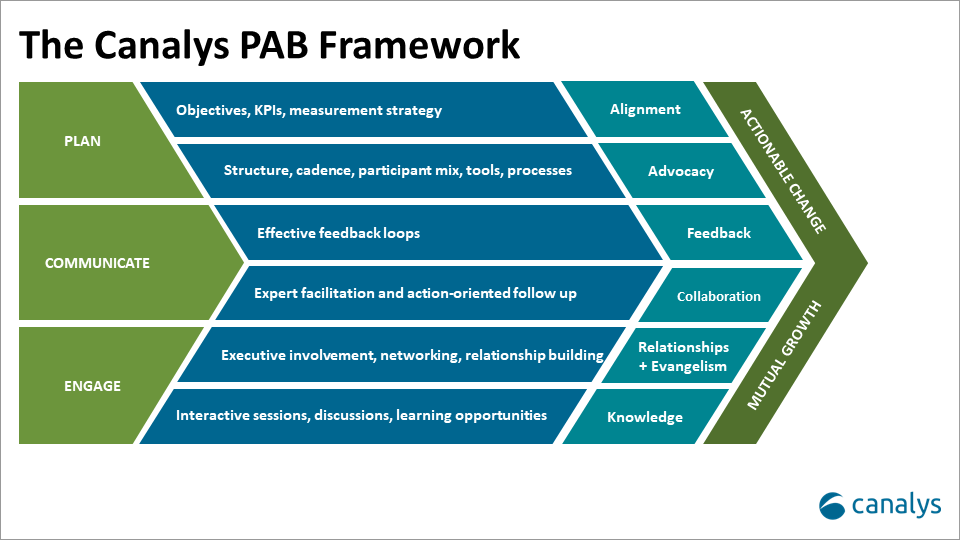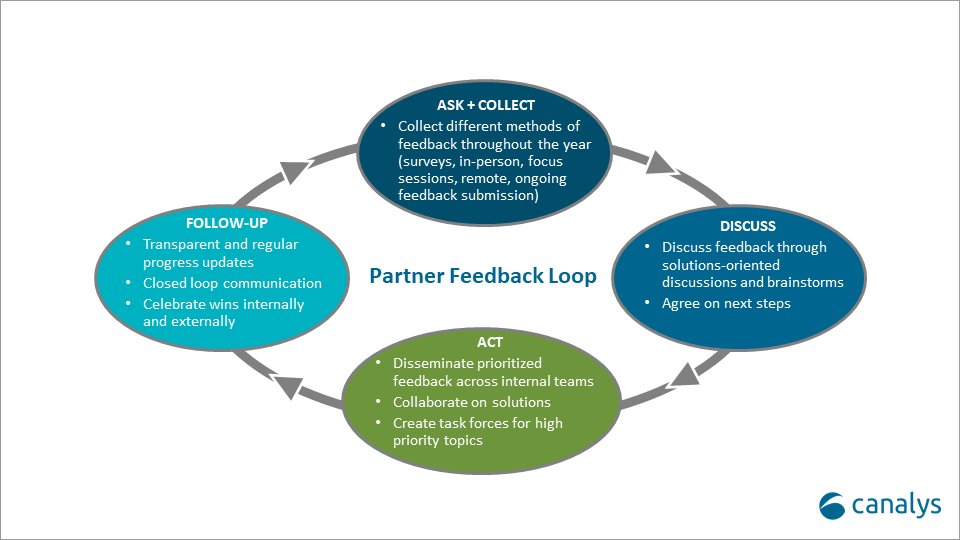Turning feedback into your greatest asset
24 January 2024
Canalys is part of Informa PLC
This site is operated by a business or businesses owned by Informa PLC and all copyright resides with them. Informa PLC’s registered office is 5 Howick Place, London SW1P 1WG. Registered in England and Wales. Number 8860726.
Leading technology vendors recognize PABs are a strategic tool for shaping customer strategies and driving growth. With a growing 73.1% of global IT business now being delivered through partners, strategic alignment with a vendor’s most important partners is more critical than ever. When executed well, PABs play a pivotal role in ensuring both parties are effectively equipped to meet ever-changing customer needs and market demands. This guide is intended for partner leaders and professionals who seek deeper collaboration with partners and explores best practices for establishing, running and optimizing PABs.
A PAB is a group of influential partners who provide insights and feedback to help vendors refine strategies and bolster mutual growth. These boards function as think tanks, offering structured channels to align priorities and foster joint success. Regular in-person and virtual meetings enable vendors to grow relationships with key partners, gather feedback, address challenges, and strengthen the business. When run well, PABs improve a business, which leads to healthier customer retention and mutual growth.
PABs fulfill six pivotal roles: to drive alignment, mutual feedback, collaboration, knowledge sharing, relationship building, advocacy, and internal evangelism. When executed effectively, these roles work together and improve business outcomes.
Understanding partners’ perceptions of PABs is important to ensure the PAB experience is mutually beneficial and drives actionable change. According to a recent Canalys survey, most partners regard PABs as productive and useful. For other partners, there is some reluctance, likely stemming from past PABs that failed to deliver meaningful objectives. Vendors should aim to understand how their partners view the effectiveness of past PABs, address the concerns of any skeptics, then utilize a framework to create a PAB strategy that drives mutual growth and learning.

A well-crafted PAB strategy focuses on how to turn partner feedback and relationship building activities into tangible business growth throughout the year. When vendors host a PAB without an overarching plan, it can lead to uncertainties around its effectiveness and, ultimately, wasted resources. A successful PAB strategy requires following a structured approach, aligning with core business objectives, and turning partner feedback into an asset to drive mutual growth and actionable change.

PABs should drive actionable change. Running a channel business is an evolving process, and PABs can play a vital role in shaping the long-term vision and providing key health checks in the day-to-day operational aspects. However, it can be challenging to focus purely on one of those aspects in any given session, and getting the overall balance can be tricky. Talking about long-term visions can appear reductive when current issues need addressing. But being overly focused on the operational minutia makes for an uninspiring session. No matter the balance of the agenda, ensure meaningful changes occur on the back of partner feedback. These tweaks and corrections are vital injections to ensure continued alignment with the partner base, and moreover, demonstrates to partners their perspective matters. It’s important that:
PABs should have clear KPIs and measurement strategies. Even the best PAB meeting and the most insightful partner feedback won’t result in long-term value if there aren’t clearly defined goals and measurable KPIs. Common goals include growing PAB partner business, improving strategies based on partner insights, creating stronger partner advocates and gaining alignment and collaboration with top partners.
PAB goals are typically measured through:
Other goals, more difficult to measure, include enhancing executive buy-in internally for partner strategies and facilitating knowledge sharing and best practices to strengthen the ecosystem.
In-person PABs should be run at least once a year, and no more than four when accounting for regional participation. Partners are inundated with industry and vendor events, and while being invited to a PAB is typically seen as an honor, it is nevertheless time taken out of a busy schedule. PABs are valuable though, and any mature vendor should strive to run at least one to two per year with digital follow up sessions. Larger vendors may run four or more PABs per year to align with different geographic regions since it is difficult to accommodate regional nuances and cultures in a global meeting. Going beyond four can start to turn PABs into repetitive burdens, both for internal stakeholders as well as participants.
When scheduling PABs, consider these best practices:
PABs should have the right mix of participants. Along with the core internal PAB team, comprised of partner executives, involvement from cross-functional partner leaders and non-partner executives is crucial for gaining essential buy-in and aligning the partner strategy with organizational objectives.
The number of partner participants also plays a role in facilitating productive discussions. A PAB should have eight to 20 partner members. This range allows for diversity of thought without hindering the quality of the interactions or becoming overly large. Smaller boards can foster deeper discussions, while larger boards offer a wider range of perspectives. Keep in mind that many vendors will split partner sales and partner technical advisory boards.
When selecting PAB participants, it’s important to focus on inviting:
PABs need supporting tools and processes, including well-established feedback loops. Establishing the infrastructure to support, automate and operationalize PABs requires the correct set of tools.
Key tools include:
From a process perspective, an established partner feedback loop is critical to turn feedback into action and ensure the insights gained are integrated into the company's overall strategies and business objectives.

In-person PABs should be designed for engagement. The agenda should be partner-focused and cover topics to drive mutual success, alignment and better overall business. Pre-event collaboration is also key to maximize participation; asking for partner and executives' input when designing the agenda creates more buy-in.
The agenda should balance:
PABs should avoid too many one-way presentations, and instead incorporate diverse formats, ranging from presentations, forums, trainings, roundtables, and social activities to foster a dynamic and interactive environment. The venue should be conducive to collaboration and the space arranged to encourage open discussion.
Each session track should start with clearly defined goals, desired outcomes and time management reminders to keep the group on track. As the meeting concludes, it is important to identify top takeaways and discuss issues that require joint resolution. Next steps should be outlined to ensure all participants are aligned on the path forward.
PABs should have an experienced facilitator. Facilitators should be well-trained in managing constructive dialogues. Prior to the PAB, facilitators should be prepared for any controversial or emotional topics likely to come up and should be armed with relevant data and reports. Facilitators should avoid a defensive stance to negative partner feedback and instead foster constructive feedback and solution development.
Many vendors opt to hire a third-party expert to oversee a PAB, adding a higher level of expertise, focus and objectivity to discussions. External moderators provide unbiased and effective facilitation, as well as expert insights to help partners improve their businesses.
Several major pitfalls can impact partner engagement and the overall effectiveness of these platforms including:
PABs, when strategically executed, transform the way vendors and partners interact, fueling alignment and growth. Without focused management, PABs become mere formalities and fail to execute on partner feedback. By setting clear objectives, devising a smart strategy, and maintaining a commitment to action, PABs unlock dynamics that lead to more successful joint customers, deeper partnerships and a competitive advantage in the market. As the technology landscape becomes increasingly complex and customers rely more heavily on partners for pre-sales and post-sales, PABs will become even more important to thriving customers and ecosystems.